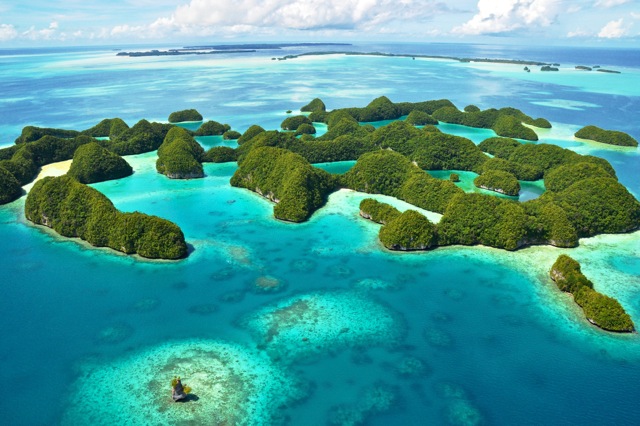Pacific Mystery: Coral Reefs Are Thriving, But How?
Jun 5, 2015
A College of Geosciences researcher and her colleagues have found healthy coral reefs in highly acidic ocean waters. "The reefs appear to be thriving, and we want to understand why," says Kathryn Shamberger, assistant professor of oceanography.

Fragile coral reefs can be barometers of healthy ocean conditions, but a large reef in Palau in the far western Pacific Ocean seems to be defying all odds – it is thriving in high levels of acidification, says a team of international researchers.
Hannah Barkley, Anne Cohen, Victoria Starczak and Thomas DeCarlo of the Woods Hole Oceanographic Institution, Yimnang Golbuu of the Palau International Coral Reef Center and Kathryn Shamberger of Texas A&M University have had their work published in the current issue of Science Advances.
The team examined eight coral reefs in the Palauan archipelago and found high levels of acidification within the lagoons and inlets of the Palau Rock Islands. But despite the high levels, the Rock Island coral reefs appear to be extremely healthy.
“Based on lab experiments and other studies, this is the opposite of what we expected,” says Barkley, the lead author.
As the ocean absorbs atmospheric carbon dioxide released by human activities, its chemistry is changing. The carbon dioxide reacts with water molecules, lowering ocean pH in a process known as ocean acidification. This process also removes carbonate ions, an essential ingredient needed by corals and other organisms to build their skeletons and shells.
Though coral reefs cover less than 1 percent of the ocean, they are ecosystems that are home to at least one-fourth of all marine life.
Why the reefs are so healthy despite the high acidification levels is one of the key questions the team wants to answer. The researchers found that acidification levels in the Palau Rock Islands are as high now as the open ocean is projected to be by the end of this century.
“The reefs appear healthy, but they have high levels of bioerosion, which occurs when organisms like mollusks and worms bore into the reef and break it down,” Shamberger adds.
“We see coral skeletons that are eaten up and have holes on top and the sides. The coral almost looks like Swiss cheese because of the volume that has been removed,” says Barkley.
“But the reefs appear to be thriving despite acidification and bioerosion and we want to understand why,” says Shamberger.
The team says that the acidification process in Palau is a natural one, due to a combination of biological activity and the slow flushing of water through the Rock Island lagoons that allows acidification levels to build up over time.
“Ocean acidification is happening in every ocean everywhere on Earth,” Shamberger says.
“We do know that adding carbon dioxide to the atmosphere from burning fossil fuels and deforestation contribute to higher acidification levels. It is very important for us to understand how coral reefs around the world will respond to continuing ocean acidification and places like Palau with natural acidification provide valuable clues.”
The project was funded by the National Science Foundation with additional funding from The Dalio Foundation Inc., The Tiffany & Co. Foundation, The Nature Conservancy and the WHOI Access to the Sea Fund.
For more information, click here.
###
Media contact: Erin Koenig, media relations coordinator, Woods Hole Oceanographic Institution, (508) 289-2270, or ekoenig@whoi.edu or Keith Randall, Texas A&M News Service, at (979) 845-4644 or keith-randall@tamu.edu
